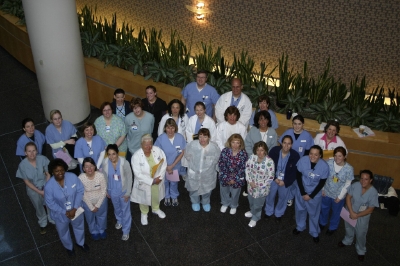Nurses Aim to Reduce Pressure Ulcer Prevalence

After an early morning meeting, the survey team is ready for action.
Nurses left no patient unturned during BWH’s fourth semi-annual pressure ulcer prevalence survey in March. A total of 527 patients were assessed, and those with possible pressure ulcers were re-assessed by the nurses on the pressure ulcer survey team.
“The enthusiasm of this group of 27 nurses—our largest yet for the survey team—was unbelievable,” said Lucy Feild, PhD, RN, Quality Program Manager, who organized the spring survey. “They really demonstrated our commitment to preventing pressure ulcers, an important nursing responsibility.”
“It was one of those times when you’re really proud to be a BWH nurse,” Diane Lancaster, PhD, RN, Director of Quality Measurement & Improvement in the Department of Nursing, said of watching the nurses on this year’s team gather at 7 a.m. for a pre-survey education session before heading up to the patient floors.
After meeting, the nurses divided into six groups, each of which was responsible for one ICU and six intermediate care pods, to examine those patients with pressure ulcers. “Four to five nurses on a team confirmed that the skin lesion was in fact a pressure ulcer and, if so, that its stage of severity was documented correctly,” Feild said.
Wound-ostomy-continence nurse specialists Ilene Fleischer, MSN, RN, CWOCN, Diane Bryant, MSN, RN, CWOCN, and Mary Willis, MSN, RN, CWOCN, were on hand to provide guidance and answer questions from the survey team.
Additional data, such as whether the pressure ulcer was present at the time of admission and if the patient was on a special mattress surface to minimize risk, also were collected. The data will be compiled by the BWH Center for Clinical Excellence and findings shared with BWH nursing staff through their nursing directors and managers. In addition, the MHA Patients First initiative posts a summary of survey data for all participating health care facilities, including BWH, on its website at http://www.patientsfirstma.org/ under “measures.”
The data will be instrumental in measuring the effectiveness of new mattresses delivered in April. These new mattresses were placed on 10 observation beds in the Emergency Department, CWN 7, and throughout the Tower, with the exception of 9AB and any special ICU beds. Remaining units will receive the new mattresses in the fall.
The AtmosAir 9000 mattresses, made by Kinetic Concepts, Inc., of San Antonio, TX, feature a self-adjusting technology designed to prevent and treat pressure ulcers. With nine air cylinders inside the mattress and a system of cut-off valves, these mattresses automatically adjust to body weight and redistribute pressure.
“These mattresses performed very well during a trial last spring on Tower 12,” said Feild. “They do not take the place of turning patients regularly and good nutrition, but they will be an important part of nursing’s efforts to prevent pressure ulcers.”
If you want to learn more about the pressure ulcer prevalence survey, wish to participate in a future survey, or have questions about the new mattresses, contact Lucy Feild at MLFeild@partners.org or ext. 5-6416.
New AtmosAir 9000 Mattresses
Tips and Reminders
1. This mattress is designed to PREVENT and TREAT pressure ulcers, including:
- stages I through IV and unstageable pressure ulcers
- suspected deep tissue injuries (DTI).
2. This mattress is effective for patients weighing up to 500 pounds, the limit of the regular hospital bed frame.
3. The foot end of the new mattress slopes down at a 12 degree angle to alleviate heel pressure. For this reason, the mattress must always be positioned with the slope at the lower end of the bed, facing up.
4. The new mattresses are cleaned by Environmental Services in the same way as the old mattresses. Please note that C. diff infection is NOT a contraindication with the new mattress.
Reminders
1. Overlays are not necessary with most patients. The pressure re-distribution provided by the AtmosAir 9000 mattress is comparable to that achieved with the KCI First Step and Gaymar overlays so these overlays are no longer be necessary in most cases.
2. Patients who may still require an overlay are those with:
- Extensive skin disorders, such as Stevens-Johnson syndrome, GVHD, TEN (toxic epidermal necrolysis)
- Extensive new flaps and skin grafts
- Severe anasarca
- Severe or extensive burns
Most of these patients are typically cared for in the ICUs or on the Plastic Surgery service.
3. If the patient’s condition warrants an overlay, it may be placed directly on top of the AtmosAir 9000 mattress.
4. Patients who have used overlays in the past may expect them to be used as part of their skin care regimen on subsequent admissions. Remember to explain to patients that the AtmosAir 9000 is equivalent to the overlay so is not needed.
5. Red dots were placed at the foot of beds whose mattresses were not replaced. Mattresses were not replaced if patients were neutropenic or on C. difficile precautions to minimize spread of infection. Environmental Services will provide a new AtmosAir 9000 mattress (purple cover) at discharge.
After an early morning meeting, the survey team is ready for action.